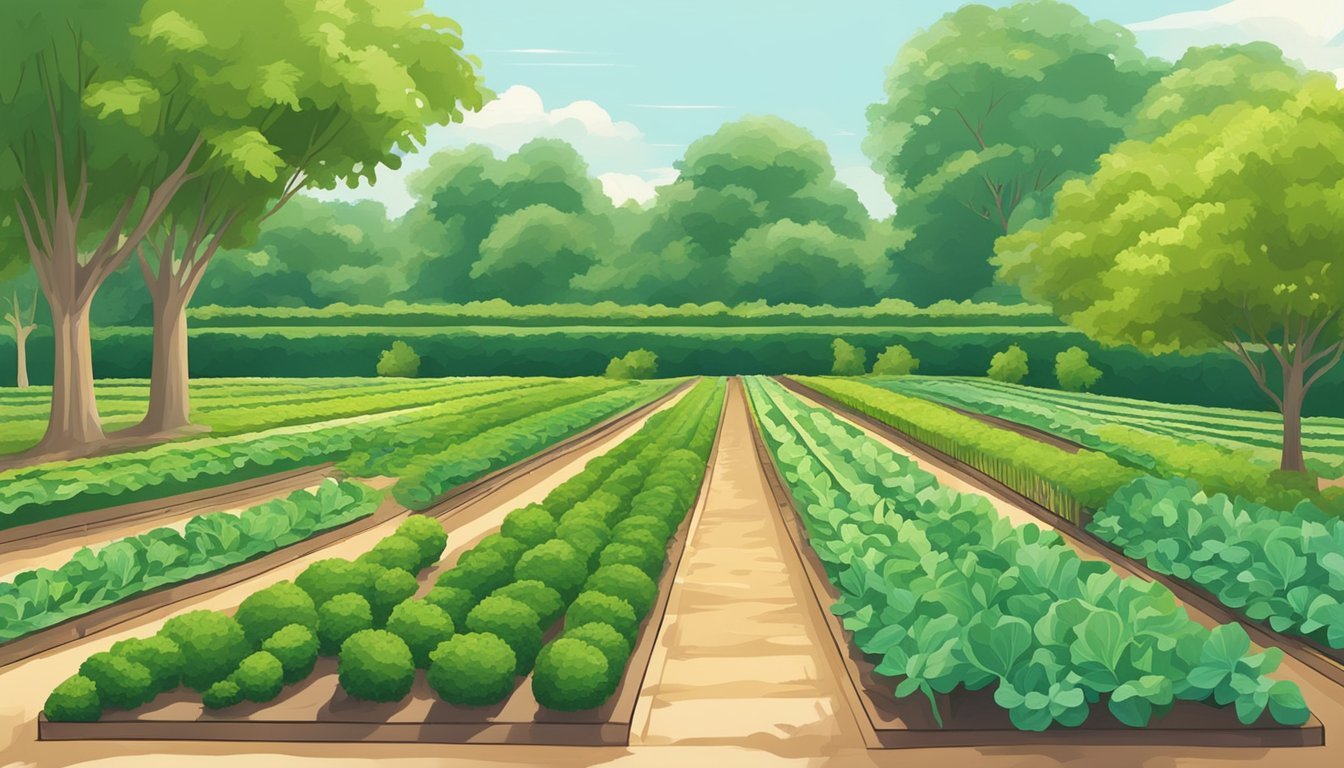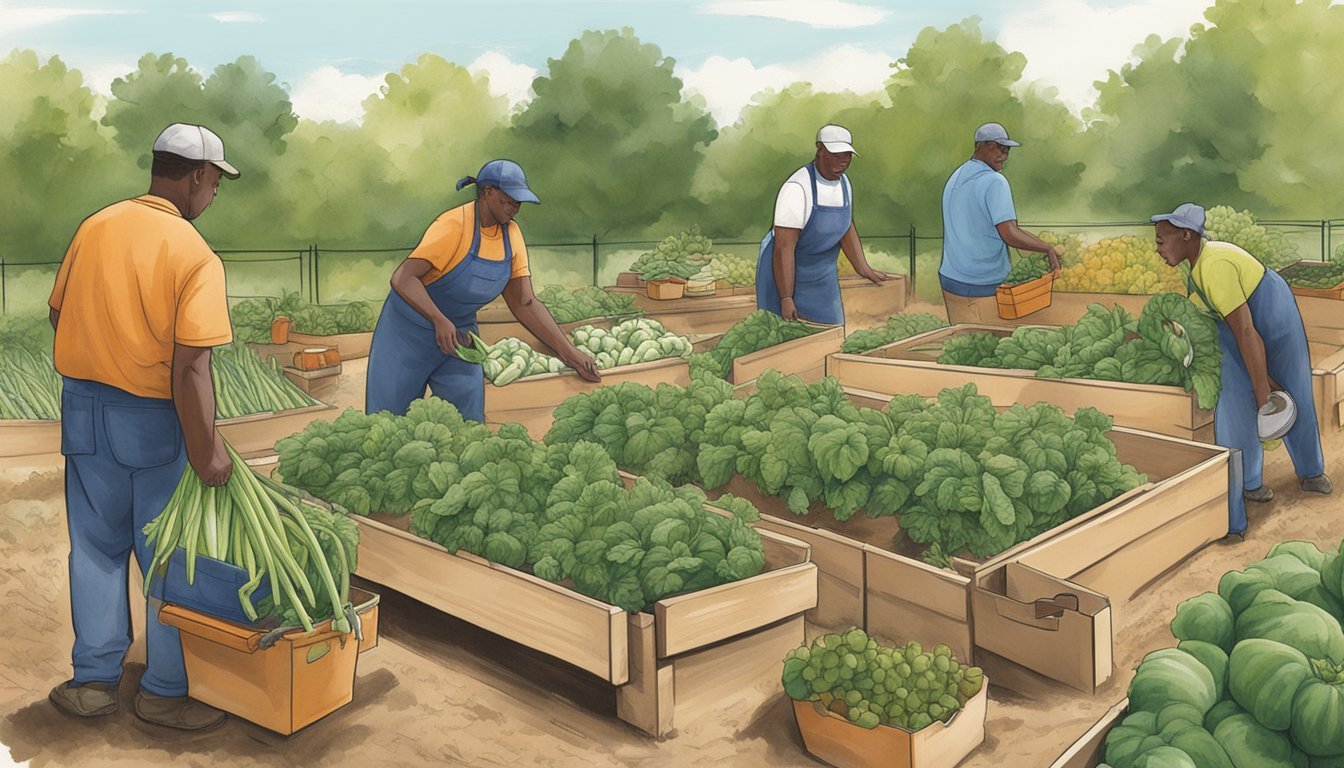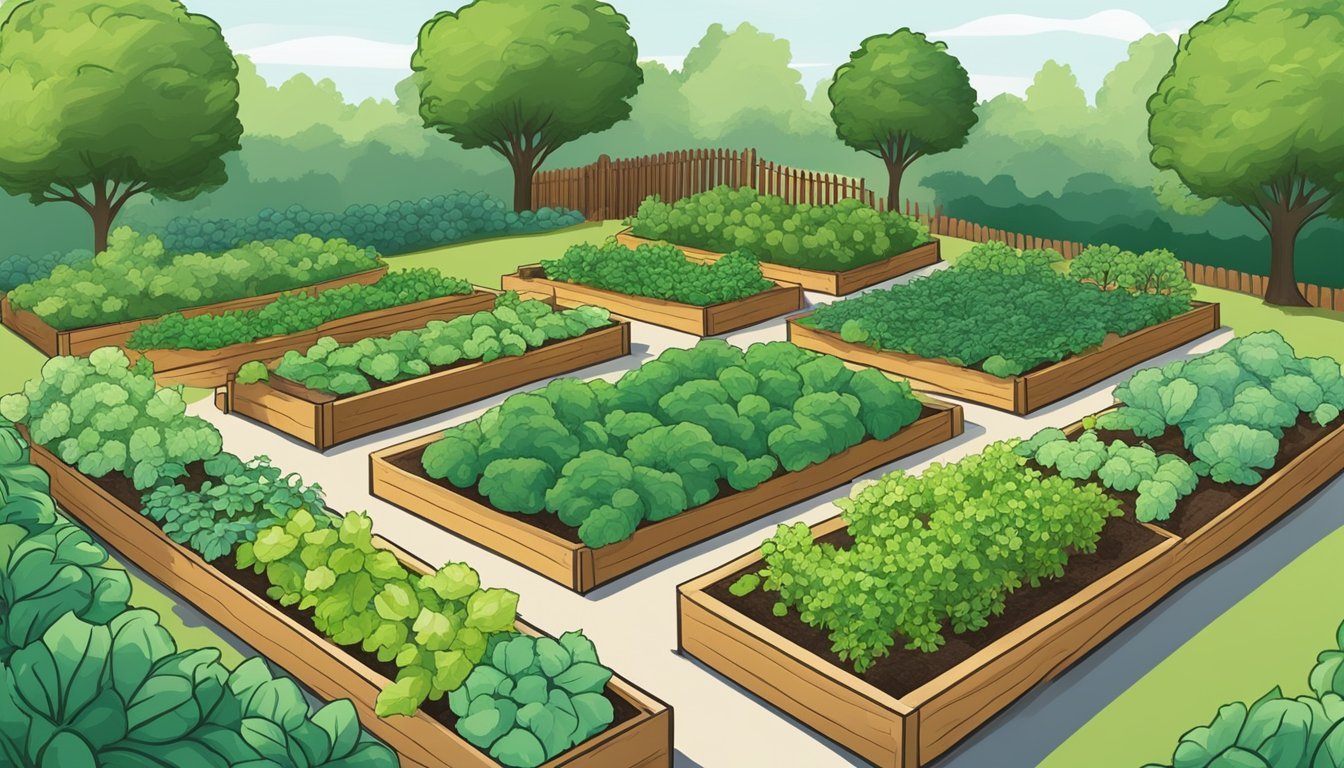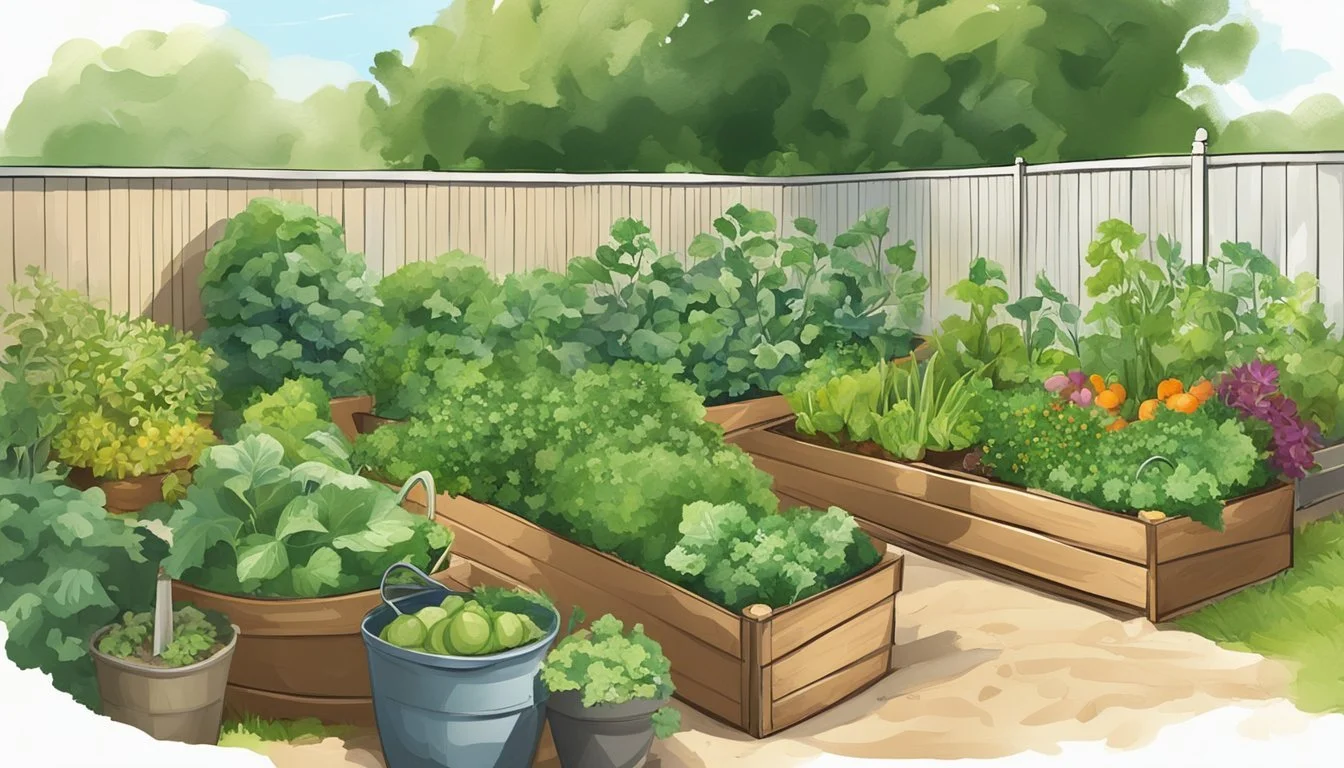Vegetable Gardening in South Carolina
Essential Tips for a Thriving Garden
This Article is Part of Our Guide on Vegetable Gardening by State
Vegetable gardening in South Carolina offers a rewarding experience for gardeners due to the region's diverse climate and extended growing seasons. The state spans USDA hardiness zones 7-9, providing a favorable environment for a variety of vegetables to flourish. The key to a successful vegetable garden in this Southern state lies in understanding the local frost dates and selecting the right time to plant. South Carolina's climate allows for both cool-season and warm-season vegetables, enabling gardeners to maximize their yield throughout the year.
Gardeners in South Carolina can enjoy fresh vegetables straight from their garden nearly all year long. With proper care and consideration of the specific regional climates within the state, a bountiful harvest is possible from the coastal plains to the upstate. Vegetables such as lettuce are particularly suited to the South Carolina climate, thriving in the cooler months and offering a low-maintenance option for the home gardener.
The growing interest in home vegetable gardens across South Carolina is not only due to the satisfaction of cultivating food but also as a practical response to rising food costs. Whether one is seeking to grow vegetables for their superior taste, as a hobby, or for economic benefits, South Carolina's gardens provide ample opportunity. The state's gardeners are increasingly finding value in the fresh, nutritious produce that they can grow at home. Careful planning and a bit of gardening know-how result in successful vegetable gardens that contribute to a sustainable and healthy lifestyle.
Getting Started with Vegetable Gardening
Embarking on a gardening journey in South Carolina requires an understanding of the regional climate, soil types, and suitable vegetables to grow. Proper equipment and thoughtful garden planning are also essential for a fruitful harvest.
Understanding South Carolina's Climate
South Carolina's climate is conducive to gardening, with USDA hardiness zones ranging from 7 to 9. This indicates a variety of plants can thrive across the state. Frost dates must be observed; typically, the growing season begins after the last frost in the spring and extends until the first frost in the fall. However, gardeners must also prepare for extreme heat, especially in summer.
Selecting the Right Location
A successful garden needs a location with adequate direct sun — most vegetables require at least 6 hours of sunlight daily. Accessibility to water and shelter from strong winds are other locational considerations. For those with limited space, raised garden beds or vertical gardening structures are ideal and can enhance productivity.
Soil Preparation and Maintenance
Soil quality is pivotal in South Carolina gardening efforts. Rich, loamy soil is the target, which may require amending with organic matter for optimized fertility. In raised beds, controlling soil composition is much simpler. Regular soil testing can guide maintenance regarding pH and nutrient levels.
Gardening Equipment Essentials
A basic toolkit should include items like spades, rakes, hoses, gloves, and pruning shears. For those investing in raised garden beds, construction materials and tools are also necessary. Good quality tools that are properly cared for can last many seasons.
Initial Planning and Design
Consider the size of your garden and the time you can dedicate to maintenance. Integrate companion planting to deter pests and diseases. Tall and trellised crops should be placed to avoid shading shorter plants. Trees and shrubs might be positioned as windbreaks or to provide shade in extreme heat.
Choosing Your Vegetables
Select vegetables that match the state's growing zones and personal tastes. Lettuce is a good choice for cooler months, while heat-loving vegetables like tomatoes (What wine goes well with tomatoes?) and peppers prosper in summer. For inexperienced gardeners, starting with less demanding vegetables can be rewarding.
Planting Your Vegetables
In South Carolina, timing and strategy are crucial when planting vegetables. Gardeners must account for the state's diverse climate and consider the right time for planting, whether starting seeds indoors or directly in the garden, and utilize techniques such as successive planting to ensure a continuous harvest.
Seasonal Planting Guide
South Carolina encompasses USDA hardiness zones 7-9, influencing planting dates for various vegetables. For spring crops, gardeners should note the last frost date to safely plant cool-season crops such as lettuce and peas. Cool-season vegetables can typically be planted as early as February in Zone 8, while the planting window extends to March for Zone 7. Here is a brief guide on when to plant some popular vegetables in South Carolina:
Spring crops (e.g., lettuce, spinach, peas): February to April
Summer crops (e.g., tomatoes, peppers, cucumbers): April to June
Fall crops (e.g., kale, broccoli, carrots): July to September
Winter crops (e.g., garlic, onions): October to November
Seed Starting Indoors vs. Outdoors
Vegetables in South Carolina can be started in two ways: indoors or directly outdoors. Starting seeds indoors allows gardeners to get a head start on the growing season, especially for vegetables like tomatoes and peppers that require longer growing periods. Seedlings should be started indoors 6-8 weeks before the last expected frost. Alternatively, vegetables such as carrots and radishes are typically sown directly into the garden because they do not transplant well.
Successive Planting for Continuous Harvest
To achieve a continuous harvest, gardeners can utilize successive planting, spacing out the seeding dates every two to three weeks. This is particularly effective for leafy greens and root vegetables, ensuring that plants can be harvested all year. It's an ideal strategy for small spaces and can provide a lot of harvest from a limited area, making it perfect for small spaces.
Spacing and Depth Strategies
Proper spacing and planting depth are crucial for the health and productivity of vegetable plants. For example, leafy vegetables can tolerate some shade and can be spaced closely if garden size is limited. In contrast, fruiting vegetables such as tomatoes and peppers require more space and need full sun. Below is a small guide for spacing and depth:
Lettuce: ¼ inch deep, 4 inches apart
Tomatoes: ½ inch deep, 24-36 inches apart
Peppers: ¼ inch deep, 18-24 inches apart
Carrots: ¼ inches deep, 2-3 inches apart
Each vegetable has unique requirements, but as a general rule, seeds should be planted at a depth approximately three times the diameter of the seed. Proper spacing ensures enough room for growth and helps prevent pest and disease issues.
Vegetable Care Throughout the Seasons
Successful vegetable gardening in South Carolina requires attentive care through each season. Gardeners must adapt their methods to account for the region's varying temperature and weather patterns to ensure robust vegetable growth.
Watering and Fertilizing
Proper watering and fertilizing are vital for sustaining vegetable crops. In the spring and fall, vegetables may need less water due to cooler temperatures and increased rainfall. However, during the hot and often dry summer months, consistent and deep watering is crucial to prevent stress on plants, especially for shallow-rooted vegetables like lettuce. Fertilization should follow the specific needs of each crop; leafy greens may benefit from nitrogen-rich fertilizers, while tomatoes prefer a balanced feed.
Fertilization Schedule:
Leafy Greens: Every 4-6 weeks with nitrogen-rich fertilizer
Tomatoes: Balanced 10-10-10 fertilizer at planting and after first fruit set
Pruning and Support for Plants
Pruning encourages healthy plant development and increases yield. Vertical gardening is a strategy that can be employed to maximize space and improve air circulation, particularly for tall and trellised crops such as cucumbers and tomatoes. Supporting structures like stakes and trellises should be in place early to avoid damaging the plants.
Support Methods:
Cucumbers and tomatoes: Use trellises or cages
Beans and peas: Use stakes or netting for climbing
Mulching and Weed Management
Mulch helps to maintain soil moisture, regulate temperature, and suppress weeds. Organic mulches, such as straw or wood chips, contribute to soil health as they decompose. Weed management is an ongoing task; regular weeding ensures that vegetables do not compete for nutrients and light.
Organic: Straw, wood chips
Inorganic: Black plastic, landscape fabric
Pest and Disease Control
Gardeners must monitor for pests and diseases that can compromise vegetable crops. Insect-prone vegetables like zucchini require vigilance and potential use of organic insecticides. Disease-prone vegetables should be rotated annually to prevent soil-borne illnesses. Preventative measures, such as choosing resistant varieties and proper spacing, can reduce the risk of diseases.
Preventative Measures:
Regular inspection for pests
Crop rotation and resistant strains for disease prevention
Harvesting and Storing Vegetables
Successful vegetable gardening in South Carolina culminates in the careful harvesting and storing of produce. This section provides techniques to recognize when vegetables are ripe for the picking, methods for harvesting, and guidelines for storage to maintain freshness.
Recognizing Vegetable Maturity
Vegetables that produce fruit, such as tomatoes and peppers, should exhibit their characteristic color and detach easily from the vine. Leafy vegetables, like lettuce, are best when the leaves are firm and vibrant, while root vegetables should be harvested when the tops of the roots push through the soil surface.
Proper Harvesting Techniques
Harvesting should be done delicately to avoid damaging the vegetables or the plant. Use sharp scissors or pruners to cut leafy greens, ensuring you leave a portion of the plant for future growth. For root vegetables, gently loosen the soil around the plant with a garden fork before pulling the roots.
Storage and Preservation Methods
Freshly harvested crops should be stored in a cool, humid environment to prolong freshness. Most vegetables can be kept in the refrigerator, while some, such as onions and potatoes, prefer dark, well-ventilated spaces. Leafy greens may be wrapped in a damp paper towel and placed in a plastic bag for refrigeration, whereas root vegetables often store well in bins with dry sand or sawdust.
Leafy Vegetables:
Refrigerate in plastic bags with a damp paper towel.
Consume within a week for optimal freshness.
Root Vegetables:
Store in a cool, dark place, possibly in bins with dry material.
Can last for several weeks to months, depending on the type.
Vegetables that Produce Fruit:
Keep at room temperature if ripening is needed; otherwise, refrigerate.
Use within a few days to a week to enjoy their peak flavor.
Specialty Gardening Techniques
In South Carolina, gardeners have the advantage of a long growing season coupled with a variety of unique gardening techniques that cater to both large spaces and the smallest of urban areas. The following methods highlight environmentally friendly practices, space-saving solutions, and intensive gardening approaches to maximize yield.
Organic Gardening Practices
Organic gardening in South Carolina focuses on sustainable and chemical-free methods to manage soil health and pests. Gardeners often use compost to enrich the soil and natural remedies like neem oil to combat common pests such as slugs, which are prevalent on lettuce in cool or wet conditions.
Hydroponics and Container Gardening
Hydroponics offers a soil-free alternative that can yield vegetables much faster than traditional gardening. This method is ideal for small spaces and allows for the cultivation of plants like lettuce and tomatoes indoors or in compact areas. Container gardening, a subset of this approach, uses pots and planters, perfect for those with limited ground space or for adding a green touch to patios and balconies.
Companion Planting
Through companion planting, gardeners in South Carolina can improve the health and yield of their gardens. For example, Marigolds planted near tomatoes can deter pests, while basil can enhance the flavor of peppers. This technique not only maximizes space but is also a natural way to protect vegetables from common pests without using harmful chemicals.
Square Foot and High-Intensity Gardening
Square foot gardening involves dividing the growing area into small square sections (typically 1x1 foot each), allowing for a clear management of space and easier maintenance. It suits those who aim for a low-maintenance garden. High-intensity gardening methods, which include vertical gardening, utilize trellises or stacking systems to grow upwards, turning even the smallest of gardens into a lush and productive space.
Extended Season Gardening
Extended season gardening allows South Carolina growers to maximize their harvest throughout the year by using protective structures and choosing the right crops. This practice is essential for achieving a productive garden even during the colder months.
Cold Frames and Greenhouses
Cold frames and greenhouses are vital structures for gardeners looking to extend their growing season. By regulating temperature and shielding plants from harsh weather, these enclosures create micro-environments where cool-season vegetables can thrive.
Cold Frames: Typically constructed with a transparent lid, cold frames trap solar energy to keep soil and air temperatures warmer than the outside environment. They are ideal for:
Hardening off seedlings in early spring.
Extending harvests of cold-hardy crops into winter.
Greenhouses: These structures can be large or small but are designed with transparent walls to allow in sunlight and maintain a stable environment for a wide range of plants. In South Carolina, greenhouses:
Serve as a controlled setting for starting seeds.
Can be heated for year-round growing.
Growing Winter Vegetables
Key to winter gardening are the cold-hardy vegetables that can tolerate or even thrive in cooler temperatures. These include:
Lettuce: A versatile leafy green that fares well in South Carolina's mild winters. Varieties like Butterhead, Boston, and Loose Leaf can be grown throughout colder seasons.
Kale: Known for its improved flavor post-frost; kale is a robust choice for a winter vegetable.
Collard Greens (how long do collard greens last?): Deeply-rooted in Southern gardening, collard greens withstand winter cold and can often be harvested into the early winter months.
Broccoli: As a cool-season crop, broccoli grows successfully in the cooler temperatures of late fall or early winter.
By incorporating these vegetables, gardeners can enjoy a fresh bounty even as temperatures drop. Remembering to pair appropriate plant varieties with proper protection methods such as cold frames and greenhouses, ensures a successful extended garden season in South Carolina.
Troubleshooting Common Garden Issues
In South Carolina, gardeners may encounter various challenges that can affect the health and productivity of their vegetable gardens. Understanding these issues is key to maintaining a thriving garden.
Pests can severely impact vegetable gardens. Regular monitoring for insects like aphids, cutworms, and tomato hornworms is crucial. A gardener may use physical barriers such as netting or apply organic pesticides to manage these pests responsibly.
Disease-prone vegetables require vigilant care. Diseases such as blight or powdery mildew often flourish in humid conditions, which South Carolina can provide. To prevent disease, one should water plants at the base to avoid wetting the foliage, space plants for better air circulation, and rotate crops yearly to prevent soil-borne diseases.
When it comes to gardening, seasonal timing is fundamental. Planting heat-sensitive vegetables like lettuce during cooler months and heat-tolerant ones like okra in the summer can help circumvent temperature-related issues.
Soil issues can range from nutrient deficiencies to improper pH levels. A gardener should test the soil annually and amend it with compost or appropriate fertilizers to maintain fertility and pH balance. A common remedy for water retention problems is adding organic matter to improve soil structure.
Key Strategies:
Pest Control: Use natural predators or organic pesticides.
Disease Management: Implement appropriate watering techniques and crop rotation.
Plant Timing: Align planting schedules with seasonal temperatures.
Soil Health: Regular soil tests followed by proper amendments.
By addressing these concerns with informed strategies, South Carolina gardeners can significantly reduce common garden issues, leading to more successful and rewarding vegetable gardening.
Advancing Your Gardening Skills
To master vegetable gardening in South Carolina, one should leverage local expertise, explore diverse crop varieties, and engage with the gardening community.
Learning from Local Resources
Local resources are invaluable for gardeners seeking to enhance their skills. In South Carolina, the USDA provides zone-specific guidelines beneficial for determining the optimal planting times and strategies. Gardeners can access state cooperative extension services for tailored advice and soil testing, which is crucial for understanding nutrient profiles and needs. Such information paves the way for healthier vegetables and better yields in one's garden.
Experimenting with New Varieties
Experimentation is key to a thriving vegetable garden. South Carolina's climate allows for a range of vegetables to flourish. Gardeners can introduce new varieties of onions, carrots, beans, peppers, tomatoes, cucumbers, lettuce, squash, collard greens, peas, spinach, eggplant, radish, and cabbage, experimenting to see which thrive best in their specific garden conditions. Testing different vegetable varieties not only enhances garden biodiversity but also potentially leads to discovering more robust and flavorful options for the region.
Gardening Community and Sharing
Participation in local gardening communities facilitates skill advancement. Sharing experiences and knowledge with fellow gardeners creates a valuable support network. One can exchange seeds or seedlings of recommended varieties suitable for South Carolina gardens, such as heirloom tomatoes or heat-tolerant lettuce, and learn novel gardening techniques. Community gardens offer firsthand experience and demonstrate the power of collaboration in the horticultural world.
Conclusion
Vegetable gardening in South Carolina is a rewarding endeavor due to its optimal growing conditions. Gardeners should strategically plan their gardens, keeping size manageably small to reduce labor while ensuring that their vegetable plots receive a minimum of six hours of direct sunlight daily.
Space and Timing: Adequate spacing—particularly for vegetables such as radishes—is essential to allow for full growth and optimal flavor. Additionally, planting times are crucial; gardeners must adhere to a planting schedule that accommodates the vegetables' growth habits and regional climate variations.
Light Requirements:
Leafy Vegetables: Can tolerate some shade
Fruit-Bearing Vegetables: Require full sun
Spring in South Carolina is ideal for short-season, cold-tolerant crops like cabbage, onions, and kale. Summer's warm temperatures necessitate generous mulching to retain soil moisture for successful germination and growth.
Key Cultivation Tips:
Plan for sufficient sunshine
Follow the correct planting schedule
Space vegetables properly
Adopt soil and moisture management practices
By following these guidelines, taking into account local planting charts and considering the specific region within South Carolina—whether it’s in zones 7, 8, or 9—gardeners can enhance their chances of cultivating a thriving and productive vegetable garden.





